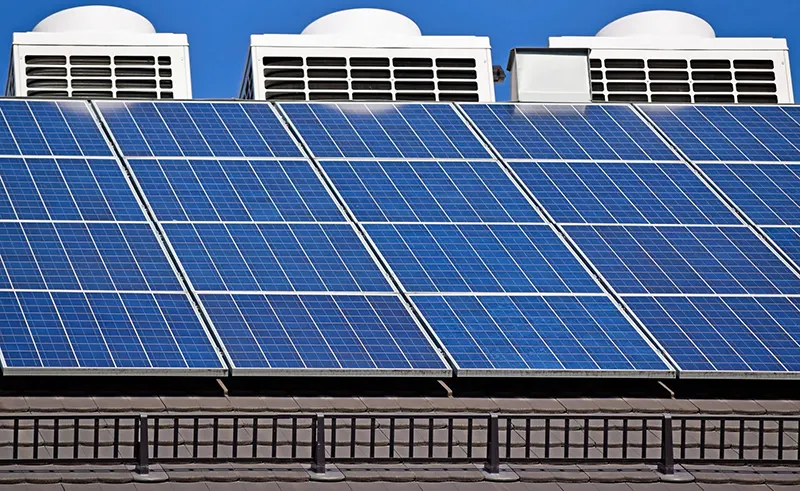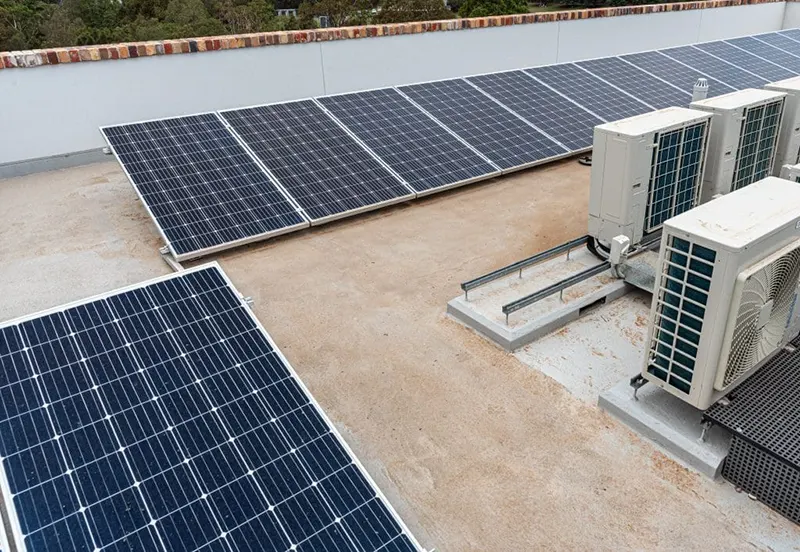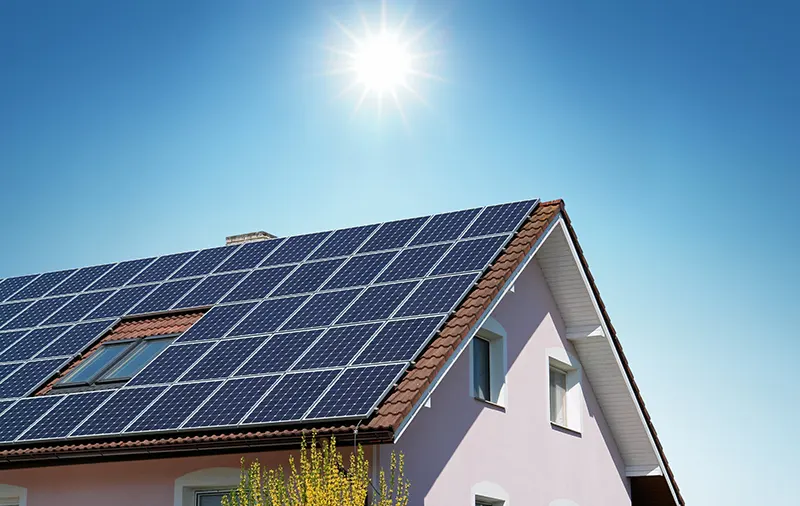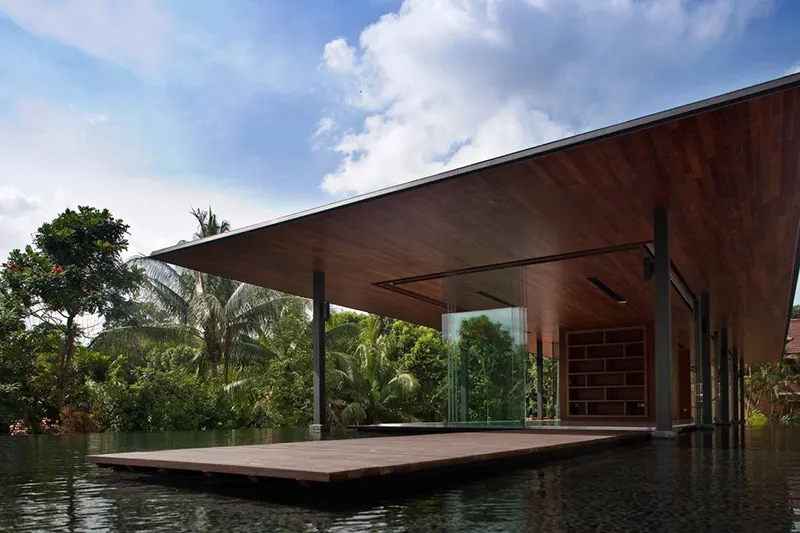Despite its cooling benefits, air conditioning is widely known to have detrimental effects on the environment. However, looking into current greener breakthroughs, could it be possible to have air conditioning off-grid?
Enjoying air conditioning off the grid is now possible. You can use solar power air conditioners, but there are a lot of other cheaper alternatives such as water coolers, ground coolers, and swamp coolers.
Learn more about off-grid air conditioners with us to get started!
Quick Navigation
- Off-Grid Air Conditioner: How Does It Work?
- Is Installing Off-Grid Air Conditioners Expensive?
- How To Set Up A Solar Powered AC Unit At Home
- Other Off the Grid Cooling Alternatives
- Conclusion
Off-Grid Air Conditioner: How Does It Work?

The whole point of off-grid air conditioning is to reduce energy consumption as much as possible. The way to do that is to use alternative energy sources like solar power. Besides being environmentally friendly, a solar-powered AC unit also cuts down costs significantly in the long run.
But how exactly does it work? Well, there are three ways to achieve off grid air conditioning:
1. DC Power
A Direct Current (DC) System charges batteries with solar power and each panel is directly wired to the DC system. This is done together with solar charge controls which are responsible for converting collected solar power energy into electricity.
Here are the major advantages of a DC air conditioner:
- Easy installation and maintenance
- Little to no issues on operating the AC unit
- Low cost
A DC system’s solar charge controllers can connect to a maximum of three solar panels and operate for up to 150 volts DC, which is good enough for smaller homes. However, larger homes and solar systems will be a challenge.
2. AC Units
The more advanced option is Alternating Current (AC) Power which is converted to DC using an off-grid inverter. AC power is less effective in charging batteries, unlike DC systems. However, they can cater to higher AC loads during the day and makes it much easier to install larger solar arrays.
Here are the major advantages of an AC powered solar air conditioner:
- Operates like a standard air conditioner without extra equipment needed
- Compatible with both solar panels and grid power
- Connecting it to the grid lets you return excess electricity and receive credits through net metering
3. Hybrid Systems
Just like how the name implies, hybrid systems are a mix of DC and AC power. This means that aside from being able to provide enough energy for your entire home, you can also store extra energy for future use. Much like a power bank! This means that even in rainy seasons, you can still save energy.
Here are the major advantages of a hybrid powered solar air conditioner:
- No extra equipment needed, less costs
- Operates anytime at any season
- Easily switch from grid power to solar power smoothly
Hybrid systems use a lot of different batteries and the best one for you will depend on your needs. To give you an idea, the affordable and widely-used batteries for a solar power system are lead-acid batteries. Whereas, lithium batteries are the superior but more costly alternative.
Is Installing Off-Grid Air Conditioners Expensive?

Most solar-powered conditioners alone cost around $5,000 with installation. However, the total costs of installing a solar-powered air conditioner is a case-to-case basis as it will depend on the number of air conditioners, solar panels, and some other factors such as:
- Photovoltaic panels (minimum of $250 per panel)
- Batteries ($2000 minimum)
- Inverter ($700 minimum)
- Solar Charge Controller ($50 minimum)
- Wiring ($50 minimum)
All this might seem very overwhelming and expensive, but it is a great investment in the long run. Plus, there is a lot of support available for people who want to start living sustainably. For instance, this upgrade might earn you a Solar Investment Tax Credit that will lower your costs by 26%.
How To Set Up A Solar Powered AC Unit At Home
Eager to get started but don’t know how? Don’t worry. We’re here to walk you over the simplest way to install an off-grid air conditioning unit for your homes.
Take note that while a DIY off-grid air conditioner may not be able to power your entire house, it’s still efficient!
Before buying or building anything, you first need to be familiar with your area’s electrical code requirements, budget, design, and utility mandates. This way, you can plan out a feasible and perfectly legal design.
What You Need
- Solar panels
- Solar charge controller
- Inverter
- Autotransformer
How To Install
Just a heads up though – the whole process is very complicated.
If you’re a beginner, we recommend asking help from your family or friends to prevent any mishaps. Also, don’t expect to finish in a day! The whole process might take you a few days at most.
1. Calculate your power load
The first step is to calculate the kilowatt hours, or how much power your AC unit consumes in a day. This is optional but highly recommended. For convenience, you can use an online off-grid calculator. But if that’s not an option at the moment, then you can do it manually.
To do this, all you have to do is multiply the number of hours you use your AC unit in a day by its power rating. The power rating is usually found in the specification chart on its user manual or somewhere around the unit itself.
2. Install solar panels on your roof

Pick the spot on your roof that’s most abundant in sunlight. You have to make sure that this area doesn’t get shaded out later in the day otherwise you might get a power outage out of the blue. Since air conditioners use a lot of energy, the bigger the solar panel, the better!
As soon as you’ve picked a spot, you can now secure your panels with a wire. Trace a junction box behind the solar panel and make sure that the wires are aligned properly. The black wire connects to negative terminals, and the red wire connects to positive terminals.
3. Connect your Solar Charge Controller
Get a Maximum Power Point Tracking (MPPT) if you need 1 kilowatt or higher. These controllers are more efficient and can transfer high voltages into your power bank.
4. Choose the best batteries
For off-grid air conditioning, we highly suggest getting lithium batteries. Although the upfront costs are quite high, they are the most efficient picks for your solar power system. Plus, they’re safe, non-toxic, sustainable, and last a lifetime!
If you’re on a budget, however, then no worries. You can still opt for lead-acid batteries for your AC unit.
5. Install an Inverter AC Unit
Inverter air conditioners are the most energy-efficient units in the market. These units can keep your home cool throughout the day with the least energy consumption of up to 240 Watts.
6. Convert DC Power to AC Power with an Inverter
We mentioned earlier that you can use AC power for off-grid air conditioning. Well, here’s how you do it:
First, get yourself a pure sine inverter which is so far the best for solar air conditioners. Then, you can use an autotransformer to double the voltage.
Just make sure that your inverter can accept the DC power harvested by your solar panels.
7. Enjoy off the grid!
And that’s it! Enjoy your new indoor off-grid system and all the privileges that come with being energy efficient.
Other Off the Grid Cooling Alternatives
Setting up a solar-powered air conditioner is ideal if you really want to go off the grid as soon as possible. However, for those with a tighter budget, then this method can be too much. Hence, we’ve also rounded up affordable and less complicated off-grid cooling options that you can switch to!
Water Cooling System

If you live near other bodies of water like streams, rivers, or springs – consider installing a water cooling system in your home!
Water cooling is a traditional Roman practice where ancient Romans ran water through their walls to keep the room cool during the summer.
In modern practice, a water cooling system can be installed with fans and heat exchangers or through a floor radiant cooling loop. This loop is where water can flow through during the summer.
Ground Cooling
Water is not the only thing that can cool you off – even the ground can!
Believe it or not, the underground temperature is actually quite comfortable. It stays the same for the whole year on the average annual temperature of the area.
Because of this, many modern buildings opted to use the ground as a thermal battery. This is mostly done by transferring indoor heat through a large tube buried a few feet below the ground via air or water.
Swamp Coolers
Swamp coolers are better for agricultural spaces. Like water cooling, they use bodies of water to cool the area. The only downside though is that it increases humidity, which can be uncomfortable for living spaces.
Conclusion
If you’re looking for greener air conditioning options, then there’s one for both on a loose and tight budget!
For those with extra to spend, your best bet is to invest in a solar-powered AC unit. Although it can cost you quite a hefty amount the first time, its long-term advantages make it worth every penny.
You can set up a DIY system yourself, but for beginners, we highly recommend getting professional help as the process is incredibly complex. On the other hand, we have three other cheaper cooling options that you can employ as well – water cooling, ground cooling, and swamp cooling.
Regardless of which method you use, you’re in for a massive change of lifestyle. It can be quite challenging at first, but rest assured that you can never go wrong with going off the grid!
